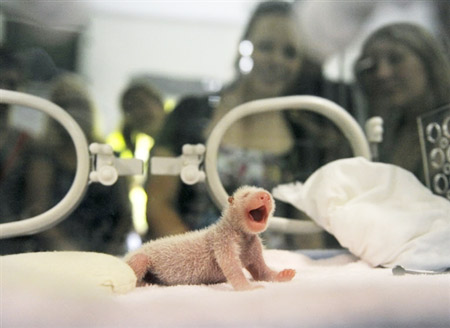Nineteen giant panda cubs were born in captivity after the May 12 earthquake in southwest China's Sichuan Province, researchers said.
|

|
|
Visitors look at a baby panda at the Chengdu Panda Breeding Research Center in southwest China's Sichuan Province July 29, 2008. [File Photo: newssc.org] |
Zhang Zhihe, the China Giant Panda Breeding Technology Commission head, said the new arrivals included nine from the China Giant Panda Research Center in the quake-hit Wolong and 10 from the giant panda breeding base in Chengdu, the provincial capital.
The cubs, including eight sets of twins, were born between July 6 and Saturday.
"Their births were not so easy," Zhang said. "They are the joint efforts of the painstaking work of the mothers, scientific researchers and quake relief workers."
About 10 pregnant pandas from Wolong were transferred to the Ya'an base in Sichuan as the massive quake, which killed nearly 70,000 people, caused great damage to their habitat.
Researchers carried out psychological comfort on the pregnant mothers who were traumatized by the quake, according to Huang Yan, a Wolong center engineer.
At July 6, Giant panda Guo Guo delivered twin pandas, becoming the first panda to bear cubs since the disaster. She was also the first panda to give birth around the globe this year.
On Saturday, a 8-year-old giant panda named "Cheng Ji" or "Achievement" in Chengdu breeding base gave birth to twin cubs at 14:24 PM and 15:17 PM They were the latest members for China's Sichuan panda family, who then were named after two of the Games' mascots as "Ying Ying" and "Ni Ni". They weighed 206 grams and 202 grams.
Giant pandas, known for being sexually inactive, are among the world's most endangered animals due to shrinking habitat.
There are about 1,590 pandas living in China's wild, mostly in Sichuan and the northwestern provinces of Shaanxi and Gansu. Through 2007, the number of captive bred giant pandas was 239 in the country.
(Xinhua News Agency August 25, 2008)